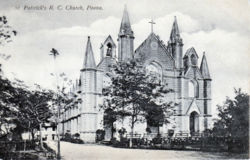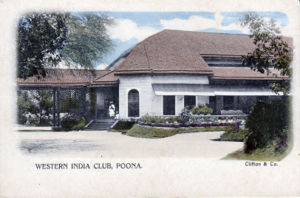Poona
| Poona | |
|---|---|

| |
| Presidency: Bombay | |
| Coordinates: | 18.520469°N, 73.85662°E |
| Altitude: | 560 m (1,837 ft) |
| Present Day Details | |
| Place Name: | Pune |
| State/Province: | Maharashtra |
| Country: | India |
| Transport links | |
| Great Indian Peninsula Railway Southern Mahratta Railway | |
| FibiWiki Maps | |
|---|---|
| See our interactive map of this location showing places of interest during the British period | |
| Poona |
THIS PAGE IS WAITING FOR MORE DETAILED INFORMATION
Poona is a city about 100km south-east of Bombay (now Mumbai), which was a popular social retreat for residents of Bombay as well as formerly the largest garrison town in the Deccan for the British Army. The British comedian, Spike Milligan, spent his childhood there (his father was in the Royal Artillery). There was also another cantonment nearby, at Kirkee.
Poona was the headquarters of Poona District in the Central division of Bombay Presidency during the British period. It was an important junction where the metre gauge Southern Mahratta Railway met the broad gauge of the Great Indian Peninsula Railway.
Modern Pune lies on the west side of the Deccan plateau beneath the Western Ghats (Sahyadri mountain range) at the confluence of the Mula and Mutha rivers. Known for its textiles and metal working, it is now the sixth largest city in India, with India's largest student population, and site of the ashram of the Orange People (followers of Sri Rajneesh).
History
Poona grew under the Moguls from 1636 as a trade route. Its importance escalated after 1750 when it became the capital of the Marathá Empire, where the Peshwas had their palace.
A battle for Poona in October 1802 between the Peshwa Bajirao II and the Holkars led to the 2nd Anglo-Maratha War.
The British involvement in Poona began after the 1802 Treaty of Bassein - when Peshwā Bjī Rao allowed the English to station a small military force in the town.
After the Peshwas were defeated at the Battle of Poona on 17/18 November 1817 (aka: Battle of Yeraoda) between the British and the Marathas near Poona in the 3rd Maratha War the city was seized. It was placed under the administration of the Bombay Presidency. The British built a large military cantonment to the east of the city (still used by the Indian Army).
The arrival of the railways opened up communication routes to Bombay, previously constrained by the terrain.
Poona Municipality was established in 1858 and was at one time the "monsoon capital" of the Bombay Presidency.
Spelling Variants
Modern name: Pune
Variants: Puna/Poona/Poonah

FIBIS Resources
English Quarters
- The Civil Lines
- Stavely Road (from the old city, heading to the Poona Cantonment)
- Poona Cantonment
Clubs
- Western India Club - English members
- Deccan Club - mixed Indian and English members
- Sanvarjanik Sabha and Deccan Sabah- Indian members
Volunteer Regiment
Education
Further Education
Poona Sanskrit College 1837 opened and offered a combined Sanskrit and medicine course (linked to Sansoon General Hospital) – under Superintendant: Captain Candy.
Sanskrit and Vernacular College est 1851/52, formed from the amalgamation of Poona’s English and Venacular schools, later it became the Deccan Arts College 1857, with an affiliation to Bombay University 1860.
The Engineering College was founded 1865 and was affiliated to Bombay University (its creation is contemporary with the construction of the Great Indian Peninsular Railway) Later (1880) it was known as the College for Science . It educated staff for the Public Works Department. Courses were offered in: Civil Engineering, Agriculture, Forestry, plus apprentice training.
Political activist Bal Gangadhar Tilak and local citizens founded The Deccan Education Society est 1884, and were responsible for founding Fergusson College, a law school, in 1885.
Schools
Supplementing native sanskrit schools, Government Schools opened in 1826 to teach vernacular, initially under control of Mr Jervis. Numbers increased to 3 Government Schools in Poona by 1847, and 23 by 1883 (many other existed in the greater Poona district). They comprised:
- High School 1
- Anglo-Vernacular 2
- Vernacular 18
- Teacher Training schools 2 (male est: 1857, female est: 1870)
In addition there were 45 Private schools, including:
- The Free Church Mission School for Girls est 1850 in the camp
- The Convent High School for Girls est 1860
- Bishops High School, est1864
- The Pensioner's Middle Class School for boys and girls est 1864
- Free Church Mission Institute est 1866
- Poona Native Institution est 1866
- St Vincent Roman Catholic High School est 1867 includes anglo-indian section,
- St Mary’s Girls High School est 1867
- St Anne’s Middle Class School for Girls est 1873
- The Victoria Girls High School est 1876
- The Free Church Mission School for Boys est 1876 in Aditvar Peth
- The Conference Middle Class School est 1879
- The Mission Orphanage and Christian Boys Middle Class School est 1879
- The New English School est 1880
- The Scottish Girls High School est 1882
- The Zanana Mission Anglo-Vernacular School for Girls est 1882 in Sukravar Peth, Sadasiv Peth *Civil Lines and Kamathipura
- The Mission Orphanage Panch Haud Vernacular School est 1882
- The Free Church Mission for Girls Vernacular School est 1882 in Aditvar Peth
- The Bene-Israel Girls Vernacular School in Rastya Peth est 1882
This India List post is about the 'posher' schools in Poona.
Hospitals
In addition to the Sansoon General Hospital, Roman Catholic Orphanage, Charitable Infirmary, St Margaret’s Hospital, St Johns Hospital, and Leper Hospital,there were 10 dispenseries in Poona.
Churches

- St Mary’s Church est 1825 originally, mainly for the officers and soldiers of the British, along with their families located in the military cantonment
- Christ Church opened by Scottish Missionaries 1831
- St.Patrick's Cathedral est 1850
- Church of the Immaculate Conception, est 1854
- St.Xavier's Church est 1864
- The St.Andrew's Church est 1864, was built to cater to the British Army personnel and their families belonging to the Church of Scotland. St.Andrew's Church,Khadki,Pune You Tube. Baptism and Marriage registers are now wth St Andrew's Church, Calcutta
- All Saints Church est 1869 (Birth, Death, Marriage and Baptism registers are all available since 1869) a military church at the Kirkee cantonment
- Methodist Marathi Church est 1872.
- The Church Of The Holy Name est 1885
- Ghorpuri Garrison Church, est 1890, now known as St.John's Telugu Church
- St Matthew's Tamil Curch est1893
- Jewish Synagogue
- United Free Church
- St Paul's Church
Cemeteries

- Sangam (near the old Residency)
- St Pauls Church
- East Street
- Kirkee close to the rifle butts
- Sholapur Road
- Kirkee Memorial for 1,800 servicemen who died in India during the First World War, who are buried in civil and cantonment cemeteries in India and Pakistan
- Kirkee War Cemetery contains 1668 Commonwealth burials from the Second World War - many graves have been reinterred at Kirkee from other sites in western and central India
- This India List post dated 25 November 2011 mentions a visit to St Sepulchre's Protestant Cemetery in the 1980s when burial records were available, however this India List post dated 15 March 2012 indicates these records are not now at the cemetery, which is very overgrown, with snakes. India List post dated 20 Apr 2012 by Edmund Bourne advises the East Gate section of the cemetery is totally in ruins. More general cemetery images may be seen here. (This report dated 21 May 2011 details a dispute with the cemetery caretaker).
- Transcriptions of monuments from St Sepulchre Cemetery, together with images are now available on the FIBIS database
Newspapers
European newspapers were the Deccan Herald, and Poona Observer.
External links
- Poona City Imperial Gazetteer
- Poona LoveToKnow 1911
- Our Troubles in Poona and the Deccan A Crawford 1897. A colourful account of local characters and their relationships with the English
- Deccan Queen: A Spatial Analysis of Poona in the Nineteenth and Early Twentieth Centuries by Wayne Thomas Mullen. Sydney University Digital Theses 26 March 2006. A thesis which is “structured around the analysis of a model that describes the Cantonment, the Civil Lines, the Sadr Bazar and part of the Native City of the Western Indian settlement of Poona in the late nineteenth and early twentieth centuries”
- "Churches" punediary: churches
- "Churches" virtualpune: churches
- "Commonwealth War Graves in Poona"
- St Mary’s Church Pune includes Archives with details of graves and memorials. This church is now part of the Church of North India.
- An Indian Boyhood: Spike Milligan recalls growing up in India in the 1920s (www.veritas) Scroll down half way. There is a brief mention of Poona and Rangoon in this interview , scroll down towards the end. An obituary from the Independent refers briefly to his time in Poona and his father, a sergeant- major in the Royal Artillery.
- Wikipedia article Chapekar brothers gives details of the 1896-1897 bubonic plague epidemic in Poona, and the murder of W C Rand, I. C. S, Chairman of the Special Plague Committee
- Maratha History Museum at the Deccan College, Pune
Historical Books Online
- Gazetteer of the Bombay Presidency Archive.org
- Poona The Imperial Gazetteer of India 1908 Digital South Asia Library
- "Map of Poona and Kirkee" between pages 342 and 343, A Handbook for Travellers in India, Burma, and Ceylon published by John Murray, London Eighth Edition 1911 Archive.org.
- The Poona Guide and Directory 1922 Archive.org
- Poona Cantonment, page 2
- Officers in the Poona Rifles, page 43